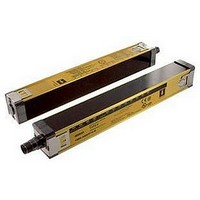F3SNA0457P25 Omron, F3SNA0457P25 Datasheet - Page 36

F3SNA0457P25
Manufacturer Part Number
F3SNA0457P25
Description
Safety Light Curtain
Manufacturer
Omron
Datasheet
1.F3SN-A0207P14.pdf
(40 pages)
Specifications of F3SNA0457P25
Beam Spacing
15mm
Control Output Type
PNP
No. Of Beams
29
Protection Height
457mm
Sensing Range Max
10m
Supply Voltage Max
24VDC
Peak Reflow Compatible (260 C)
No
Light Curtain Type
Safety
Lead Free Status / RoHS Status
Contains lead / RoHS non-compliant
<Systems with a Smallest Detectable Object Size (Diameter) Greater
than 40 mm or Systems Using Multi-beam Safety Sensors>
Assuming K = 1,600 mm/s and C = 850 mm, the following calculation
is made using Eq. (1).
S = 1,600 mm/s x (Tm + Ts) + 850 … Eq. 4,
Calculation example:
When Tm = 0.05 s and Ts = 0.01 s,
S = 1,600 mm/s x (0.05 s + 0.01 s) + 850 mm = 946 mm
How to calculate the safety distance specified by
American standard ANSI B11.19
(Reference)
<Systems with a Smallest Detectable Object Size (Diameter) Less
than 64 mm>
If a person approaches the detection zone of the Safety Light Curtain
perpendicularly, calculate the safety distance as shown below.
S = K x (Ts + Tc + Tr + Tbm) + Dpf
Approach speed K is not specified in the ANSI B.11.19 standard. To
determine the value of K to apply, consider all factors, including the
operator's physical ability.
If a machine has a brake monitor, "Tbm = Brake monitor setting time
- (Ts + Tc)". If it has no brake monitor, we recommend using 20% or
more of (Ts + Tc) as additional time.
According to ANSI's formula, Dpf is calculated as shown below:
Dpf = 3.4 x (d - 7.0): Where d is the detection capability of the Safety
Light Curtain (unit: mm)
[Calculation example]
When K = 1,600 mm/s, Ts + Tc = 0.06 s, brake monitor setting time =
0.1 s, Tr = 0.01 s, d = 14 mm:
Tbm = 0.1 - 0.06 = 0.04 s
Dpf = 3.4 x (14 - 7.0) = 23.8 mm
S = 1,600 x (0.06 + 0.01 + 0.04) + 23.8 = 199.8 mm
S = Safety distance (mm)
Tm = Machine's response time (s)
Ts = Response time of the Safety Light Curtain from ON to OFF (s)
S: Safety distance
K: Approach speed to the detection zone (the value recommended
by OSHA standard is 1,600 mm/s)
Ts = Machine's stop time (s)
Tr = Response time of the Safety Light Curtain from ON to OFF (s)
Tc = Machine control circuit's maximum response time required to
activate its brake (s)
Tbm = Additional time (s)
Dpf = Additional distance
http://www.ia.omron.com/
Method for Calculating the Safety Distance as Provided by
ANSI/RIA R15.06 (USA)
(Reference)
<Systems with a Smallest Detectable Object Size (Diameter) Greater
than 64 mm and Less than 600mm>
The safety distance is calculated based on the following concepts
when the human body intrudes perpendicular to the detection zone of
the Safety Light Curtain.
S = K x (Ts + Tc + Tr ) + Dpf
If the Sensor is installed with the lowest beam height above the floor
at 300 mm or lower and the highest beam height above the floor at
1,200 mm or higher, the Dpf will be 900 mm.
If the Sensor is installed with the lowest beam height above the floor
at 300 mm or lower and the highest beam height above the floor at
900 mm or higher, the Dpf will be 1,200 mm.
[Calculation example]
K = 1,600 mm/s, Ts + Tc = 0.06s,
If Tr = 0.01 s and Dpf = 900 mm:
S = 1,600 x (0.06 + 0.01) + 900 = 1,012 mm
S: Safety distance
K = Intrusion speed into detection zone (1,600 mm/s min.
recommended by OSHA)
Ts = Stop time of machine/equipment (s)
Tr = Light curtain ON-to-OFF response time (s)
Tc = Maximum response time of the machine/equipment braking
circuit required to operate the brake (s)
Dpf = Additional distance (mm)
Height of the lowest beam
= 300 mm or less
Height of the highest beam
= 1,200 mm or greater
Dpf=900mm
1,200
(c)Copyright OMRON Corporation 2007 All Rights Reserved.
300
Precautions for All Safety Sensors
Height of the lowest beam
= 300 mm or less
Height of the highest beam
= 900 mm or greater
Dpf=1,200mm
900
300
C-2











